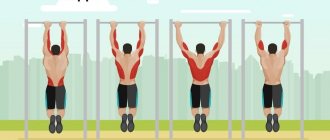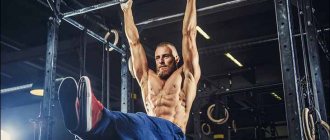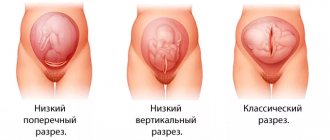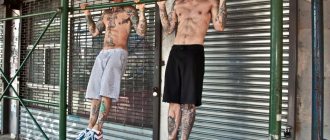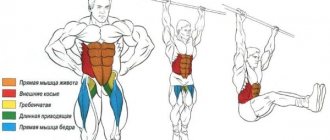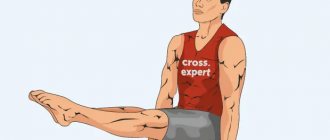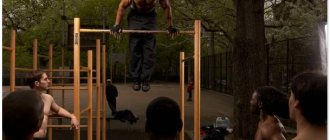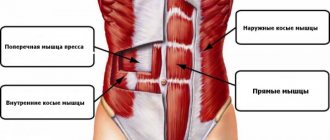If we follow the example of our fathers and grandfathers, we can answer the question by familiarizing ourselves with the requirements and standards of the GTO for men aged 40 years. According to data taken from the Resolution of the Central Committee of the CPSU and the Council of Ministers of the USSR dated January 17, 1972 No. 61 “On the introduction of the new all-Union physical education complex “Ready for Labor and Defense of the USSR” (GTO)”, and the fifth level, which is called “Vigor and health" and is aimed at checking the physical fitness of citizens: men aged from 40 to 60 years, and women - from 35 to 55 years old, we can safely say that a man at the age of forty is not at all obliged to do pull-ups.
How to determine your pull-up norm at 40 years old?
But I propose to approach this issue a little differently.
There is a certain basis of physical health that every man, and even woman, should have. It is needed in order to exist normally and perform everyday work, or in case of an emergency, to be able to get out of it without anyone’s help.
Even if you ignore the value of physical health for existence, stating: “Emergency situations in my life are excluded, because I work from home, and only go outside to the store,” the ability to do pull-ups will indicate satisfactory health of the body. As they say: “Movement is life.” The ability to perform a pull-up exercise indicates that the blood vessels, musculoskeletal system and muscles are not exhausted.
Unfortunately, most men, even at an earlier age, are not able to fulfill the GTO standard. Therefore, there is no need to talk about people over 40.
In my opinion, you shouldn’t focus on any standards and perform four or eight repetitions. Of course, performing pull-ups in this rep range at the age of 40 is quite a decent result, but is it worth stopping at these numbers? Definitely not! Who said you need to do eight push-ups? You need to constantly develop and you shouldn’t stop there, at least if you train with your own weight and there are no health restrictions.
Standards for pull-ups on the bar by age
One of the simplest, most accessible, common, and effective ways to build muscle mass, increase the strength qualities of arm muscles, and reaction speed is to do pull-ups on a horizontal bar. This type of exercise is used by all athletes involved in strength-related physical activities. Standards for pulling up, due to their simplicity, are included in the physical education programs of pupils, students, cadets, and law enforcement officers.
Table of standards for pull-ups at school
| Pull-up | Boys | ||
| 5 | 4 | 3 | |
| 1 class | 4 | 2 | 1 |
| 2nd grade | 4 | 2 | 1 |
| 3rd grade | 5 | 3 | 1 |
| 4th grade | 5 | 3 | 2 |
| 5th grade | 7 | 5 | 3 |
| 6th grade | 8 | 6 | 4 |
| 7th grade | 9 | 7 | 5 |
| 8th grade | 10 | 8 | 5 |
| 9th grade | 11 | 9 | 6 |
| Grade 10 | 12 | 10 | 7 |
| Grade 11 | 14 | 11 | 8 |
GTO standards for hanging pull-ups on the bar:
| GTO pull-up from hanging on the horizontal bar | Boys | ||
| 1st stage (6-8 years) | 2 | 3 | 4 |
| Level 2 (9-10 years) | 2 | 3 | 5 |
| Level 3 (11-12 years old) | 3 | 4 | 7 |
| Level 4 (13-15 years old) | 6 | 8 | 12 |
| Level 5 (16-17 years old) | 9 | 11 | 14 |
| Men | |||
| Level 6 (18-24 years old) | 10 | 12 | 15 |
| Level 6 (25-29 years old) | 7 | 9 | 13 |
| 7th stage (30-34 years old) | 5 | 7 | 12 |
| 7th stage (35-39 years old) | 4 | 6 | 10 |
| 8th stage (40-44 years old) | 4 | 6 | 9 |
| 8th stage (45-49 years old) | 3 | 5 | 8 |
| 9th stage (50-54 years old) | 2 | 4 | 7 |
| 9th stage (55-59 years old) | 2 | 3 | 6 |
Video about passing the GTO standards:
It is important to note that the benefits of pull-ups are not only in strengthening the muscles of the arms, but also in the general preparation of the body for power loads, a positive effect on the spine, and strengthening of ligaments. Depending on the type of grip you have on the bar, you can alternate training different muscle groups.
But the most important thing is that there is no need for any exercise equipment, free space, or preliminary preparations - you can install a horizontal bar in the corridor of an ordinary apartment, and its effectiveness will not be inferior to the apparatus installed in the stadium. To this you need to add a little desire, persistence and free time (up to half an hour a day will be enough).
What muscles are trained?
Before considering the execution technique, it is advisable to consider which muscle groups are involved in the pull-up process. If we consider essentially, then in this case almost all the muscles of the upper body are loaded, namely:
- pectoralis major and minor muscles;
- all back muscles;
- biceps, triceps;
- abdominal muscles (all types);
- muscles of the forearm, shoulders.
The load on a particular muscle will directly depend on the position of the hands on the horizontal bar, as well as the order in which the exercises are performed. In some cases, using a horizontal bar you can also train your leg muscles (for example, if you lift them into a corner). In other words, by selecting the type of exercise, the athlete will ensure the development of muscle mass and the formation of a certain relief of his body.
Basic methods of pulling up
You can perform a wide variety of physical exercises on the horizontal bar. Even a minimal change in arm position immediately loads other muscle groups. And if you alternate all this correctly, then engaging in such sports will not lead to excessive exhaustion of the body, and will allow you to harmoniously develop and physically strengthen your body.
When performing a classic pull-up with a front grip, you should consider the following points:
- With a narrow grip, the maximum load falls on the triceps. Other muscles here play more of a supporting role.
- With a medium grip, the shoulders and forearms are loaded. This strengthens the ligaments, as well as the trapezius and biceps. Great after performing specialized exercises to target these muscle groups.
- A wide grip provides maximum training for the back muscles. The wider the grip, the more your back is engaged and developed. To enhance the effect, it is advisable to do push-ups not under the throat, but behind the neck.
When considering ways to grip the horizontal bar during exercises, you need to take into account the following features:
- Classic (straight) grip. In this case, the palms are directed away from the athlete's face. The horizontal bar is completely enclosed in the lock. The hands are at the width of a comfortable position for pulling up, unless a special exercise is performed with a modified grip.
- Underhand (reverse) grip. Here the palms clasp the crossbar and look towards the athlete’s face. The thumb on each palm should act like a lock, tightly adjacent to the other fingers of the hand.
- Parallel (neutral) grip. It is used not on the horizontal bar, but on crossbars located parallel to each other. In this case, the palms face each other. The width of the grip is equal to the width of the crossbars.
To ensure uniform development of all muscle groups in your body, you need to alternate gripping the horizontal bar and positioning your hands. The most universal way to evenly influence all muscle groups is the classic medium grip. All other hand positions will pump specific muscles.
If an athlete is focused not only on development, strengthening, but also building muscle mass, it is necessary, in addition to the usual pull-ups, to complicate the procedure with a variety of weights. This should be done under the supervision of an instructor or trainer. You need to increase weight gradually, so as not to cause the body sprains, muscles, or injured bones.
Execution technique
To achieve the maximum effect from training, it is very important to perform the exercises correctly. In practice, this means adhering to the following features of performing actions:
- Hands shoulder width apart
- During pull-ups, it is not allowed to sway the body and use inertia as an auxiliary factor. Here you need to use your own muscles as much as possible;
- the body rises up smoothly, without any jerks;
- the pull-up is considered completed once the chin is above the horizontal bar;
- it is necessary to lower the body to its original position without jerking, at the same speed as it was pulled up;
- pay attention to proper breathing. When going up, you need to exhale, while when going down, you inhale;
- the horizontal bar is tightly grasped with hands clenched like a lock;
- The body must be kept strictly vertical to the ground surface.
The listed rules apply in all basic cases of performing pull-ups. At the same time, when individual special exercises are performed that load specific types of muscles, other features of the exercise will need to be taken into account.
In particular, you need to consider:
- When pulling yourself up with a narrow classic grip, at the top point you need to touch the horizontal bar with your chest, while your gaze is directed to your hands.
- During pull-ups with a reverse close grip, the athlete should move his shoulders back slightly and bring his shoulder blades together. This will ensure maximum comfort and benefit from this exercise.
- When performing a pull-up exercise with a classic medium grip, you need to touch the bar with your chest and bring your shoulder blades together as much as possible. The arms must be fully straightened before each start of the next pull-up.
- When the body is raised upward with a neutral grip, most of the muscles that work are the back and biceps. Therefore, you need to look up, at the final upper point, touch the horizontal bar with your chest, your elbows should look down.
- Wide grip pull-ups should be done with a straight back and straight legs. You reach the top point with the back of your neck (the bar should be behind your head). Elbows point down. You need to move your head forward a little so that you don’t hit the bar with it.
How to start these exercises correctly
Watching trained athletes, it may seem that pull-ups are a fairly easy and simple activity. But in reality it may not be tech at all. Especially for people who have not previously performed such actions or are overweight. In this case, the risk of injury during a fall from the crossbar, sprained ligaments, muscles, or incorrect landing after performing a pull-up increases significantly.
Therefore, in order to avoid troubles during starting exercises, the following nuances should be taken into account:
- False pull-ups. The exercises are performed near a wall bars on which a horizontal bar is installed. The athlete helps himself to achieve the desired position by moving his legs along the bars of the wall.
- Pull-ups with a partner. Taking positions upward and starting the exercise is carried out with the help of an experienced partner, who belays the beginner both when moving the body up (here he helps him) and when going down (in this case he does not allow him to sharply return to the starting position and fall off).
- Half pull-ups. Here you will need to install a chair or other support in order to rise halfway to the desired goal. Typically the arms become bent to a 90 degree position. You spend the rest of the time on your own and lower yourself back onto the support. Gradually, the height of the support can be reduced until the arms are fully straightened.
- Using elastic bands or exercise machines. In essence, these are the same assistants with the help of which a person’s own effort during the ascent and the need to hold the body when going down are significantly reduced. They can be adjusted for load, gradually moving to their own weight.
Remember, you don’t need to try to get an Olympic result in one day. Increase the intensity and quantity of pull-ups gradually, accustom your body to stress, strengthen your muscles, bones and ligaments. And very soon you will change the relief of your body beyond recognition and will be able to show real sports tricks.
| 1st stage (6-8 years) | 2 | 3 | 4 |
| Level 2 (9-10 years) | 2 | 3 | 5 |
| Level 3 (11-12 years old) | 3 | 4 | 7 |
| Level 4 (13-15 years old) | 6 | 8 | 12 |
| Level 5 (16-17 years old) | 9 | 11 | 14 |
| Men | |||
| Level 6 (18-24 years old) | 10 | 12 | 15 |
| Level 6 (25-29 years old) | 7 | 9 | 13 |
| 7th stage (30-34 years old) | 5 | 7 | 12 |
| 7th stage (35-39 years old) | 4 | 6 | 10 |
| 8th stage (40-44 years old) | 4 | 6 | 9 |
| 8th stage (45-49 years old) | 3 | 5 | 8 |
| 9th stage (50-54 years old) | 2 | 4 | 7 |
| 9th stage (55-59 years old) | 2 | 3 | 6 |
How to start doing pull-ups at age 40?
Pull-ups are a physically challenging exercise even at twenty years old. Both over the age of forty and people with poor physical fitness should begin pull-ups with exercises such as:
- Push ups. Even if push-ups are not possible, you can simplify them by performing the movement from your knees or on a height, for example, from a table or even a wall. 5-10 repetitions will be enough to start with. The exercise is performed in 2-3 approaches.
- Hanging on the horizontal bar - this exercise is performed for a while. The maximum time to complete the exercise is 1 minute. Hanging beyond the specified time is not effective.
- Negative pull-ups are a simple exercise. It is performed from a hill and starts from the highest point of the amplitude. The number of repetitions is 5-10, the number of approaches is 2-3.
- Pull-ups to half amplitude. The exercise is not performed in full amplitude, for example, a person pulls himself up to the middle of the amplitude, and then pauses, pausing for a second at one point, and slowly returns to the starting position (hanging).
And also read: Pull-up band - how to choose and use → How many pull-ups did Arnold Schwarzenegger do → How many times did Karelin do pull-ups → Is it possible to get pumped up at 30? All types of pull-ups and grips →
Features of training on the horizontal bar after 45 years
In recent years, exercise on the horizontal bar after 40 has become increasingly popular, especially among people who previously did not have time to maintain physical fitness. Not everyone knows how to use a horizontal bar after 40 years or after 50.
After thirty years, a gradual decline in physical activity begins, in which:
- body flexibility decreases;
- muscle mass decreases;
- kidney activity slows down;
- bone mass decreases;
- the amount of body fat increases.
All this inevitably affects material metabolism and the development of various diseases, so the risk of injury during training on the horizontal bar at the age of 50 increases and this must be remembered.
Maximum result
As the Chinese proverb says, in everything bad there is something good, so pull-ups also have their undeniable advantages and useful qualities. For example, among all the exercises that strengthen the arm muscles, push-ups give the maximum result. If you compare this exercise with push-ups, abs or anything else, then pull-ups really give the most results. But this is on one condition - if you perform this exercise correctly. So before you start doing pull-ups, it’s better to make sure how well you know the technique.
